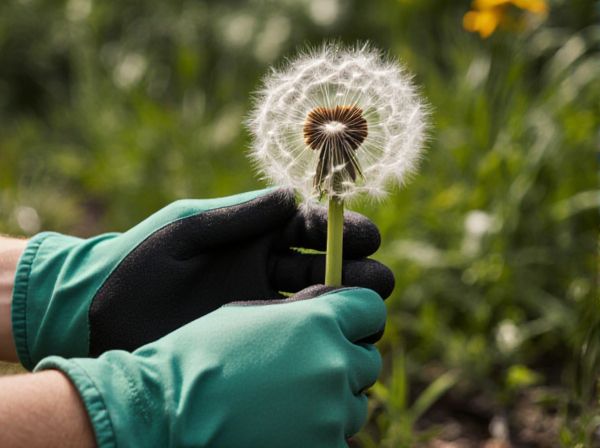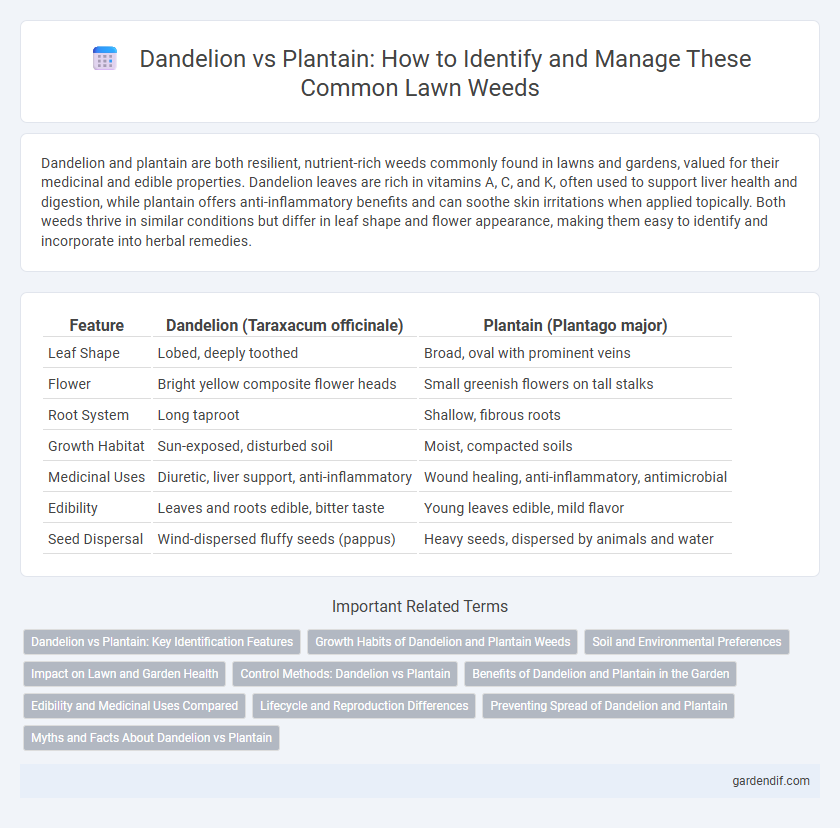
Dandelion vs Plantain Illustration
Dandelion and plantain are both resilient, nutrient-rich weeds commonly found in lawns and gardens, valued for their medicinal and edible properties. Dandelion leaves are rich in vitamins A, C, and K, often used to support liver health and digestion, while plantain offers anti-inflammatory benefits and can soothe skin irritations when applied topically. Both weeds thrive in similar conditions but differ in leaf shape and flower appearance, making them easy to identify and incorporate into herbal remedies.
Table of Comparison
| Feature | Dandelion (Taraxacum officinale) | Plantain (Plantago major) |
|---|---|---|
| Leaf Shape | Lobed, deeply toothed | Broad, oval with prominent veins |
| Flower | Bright yellow composite flower heads | Small greenish flowers on tall stalks |
| Root System | Long taproot | Shallow, fibrous roots |
| Growth Habitat | Sun-exposed, disturbed soil | Moist, compacted soils |
| Medicinal Uses | Diuretic, liver support, anti-inflammatory | Wound healing, anti-inflammatory, antimicrobial |
| Edibility | Leaves and roots edible, bitter taste | Young leaves edible, mild flavor |
| Seed Dispersal | Wind-dispersed fluffy seeds (pappus) | Heavy seeds, dispersed by animals and water |
Dandelion vs Plantain: Key Identification Features
Dandelion leaves are deeply toothed with a distinctly jagged edge and form a basal rosette, while plantain leaves are broad, oval-shaped with parallel veins and a smoother edge. Dandelion flowers are bright yellow and appear singly on hollow stems, whereas plantain flowers are small, greenish, and clustered on a tall spike. The taproot of the dandelion is thick and fleshy compared to the fibrous root system of the plantain.
Growth Habits of Dandelion and Plantain Weeds
Dandelion weeds exhibit a deep taproot system that enables them to survive adverse conditions and rapidly regenerate after removal, while their rosette growth habit allows them to spread efficiently across lawns and disturbed soils. Plantain weeds grow low to the ground with broad, oval leaves that form a dense rosette, emphasizing horizontal growth and helping them outcompete surrounding vegetation. Both species demonstrate resilient growth habits that challenge weed management strategies in home gardens and agricultural fields.
Soil and Environmental Preferences
Dandelions thrive in well-drained, nutrient-rich soils and tolerate a wide range of environmental conditions, including full sun and moderate drought. Plantains prefer compacted, moist soils often found in disturbed urban areas and can grow in partial shade as well as full sun. Both weeds demonstrate adaptability but differ in soil moisture tolerance and shade preference, impacting their distribution across diverse habitats.
Impact on Lawn and Garden Health
Dandelion aggressively competes for nutrients and water, often creating bare patches that weaken lawn resilience and encourage weed invasion. Plantain exhibits a deep root system that aerates compacted soil but can outcompete grass if left unmanaged. Both weeds can disrupt garden health by dominating growing space, but plantain's soil benefits can aid long-term lawn recovery when controlled.
Control Methods: Dandelion vs Plantain
Effective control of dandelion involves the use of broadleaf herbicides containing 2,4-D or dicamba, combined with regular lawn mowing and proper fertilization to prevent seed spread. Plantain control requires a similar approach, emphasizing manual removal due to its deep taproot, alongside pre-emergent herbicides to inhibit germination. Maintaining healthy soil and dense turfgrass can suppress both weeds by reducing open space for establishment.
Benefits of Dandelion and Plantain in the Garden
Dandelion and plantain both enhance garden health by improving soil quality and supporting pollinators; dandelion's deep taproots break up compacted soil and draw nutrients to the surface, while plantain acts as a natural ground cover that reduces erosion. Their flowers attract beneficial insects like bees and butterflies, boosting biodiversity and aiding in pollination of other plants. Both weeds also serve as nutritious food sources for wildlife, contributing to a balanced garden ecosystem.
Edibility and Medicinal Uses Compared
Dandelion (Taraxacum officinale) and Plantain (Plantago major) both offer edible leaves rich in vitamins A, C, and K, with dandelion providing a slightly bitter flavor ideal for salads and teas. Medicinally, dandelion supports liver detoxification and diuretic functions, while plantain is renowned for its anti-inflammatory properties and wound-healing capabilities. Both plants deliver valuable phytochemicals like antioxidants and flavonoids, making them beneficial additions to natural remedies and dietary supplements.
Lifecycle and Reproduction Differences
Dandelions (Taraxacum officinale) reproduce primarily through apomixis, enabling them to create seeds without fertilization, resulting in rapid population growth with a lifecycle that completes in a single growing season. Plantains (Plantago major) reproduce sexually through wind-pollinated flowers, producing seeds genetically diverse yet slower to spread compared to dandelions, with a perennial lifecycle that allows them to survive multiple years. The dandelion's efficient seed dispersal via wind-blown pappi contrasts with the heavier, ground-dispersed seeds of plantain, impacting their respective colonization strategies.
Preventing Spread of Dandelion and Plantain
Controlling the spread of dandelion and plantain requires timely identification and removal of young plants before they produce seeds. Applying appropriate herbicides and maintaining healthy turf through regular mowing and proper fertilization reduces weed colonization. Mulching garden beds and improving soil drainage also inhibit the growth and dissemination of both dandelion (Taraxacum officinale) and plantain (Plantago major).
Myths and Facts About Dandelion vs Plantain
Dandelion and plantain are often mistaken for each other due to their common presence in lawns and similar uses in herbal medicine; however, dandelion leaves are deeply toothed and milder in taste, while plantain leaves are broad and ribbed with a slightly bitter flavor. A widespread myth claims dandelions are purely invasive weeds with no nutritional value, but they are rich in vitamins A, C, and K, and used for detoxification and digestion. Plantain is wrongly believed to cause allergic reactions, yet it possesses anti-inflammatory properties and is traditionally used to soothe insect bites and skin irritations.
Dandelion vs Plantain Infographic

 gardendif.com
gardendif.com